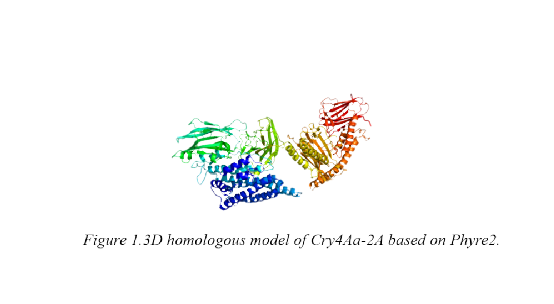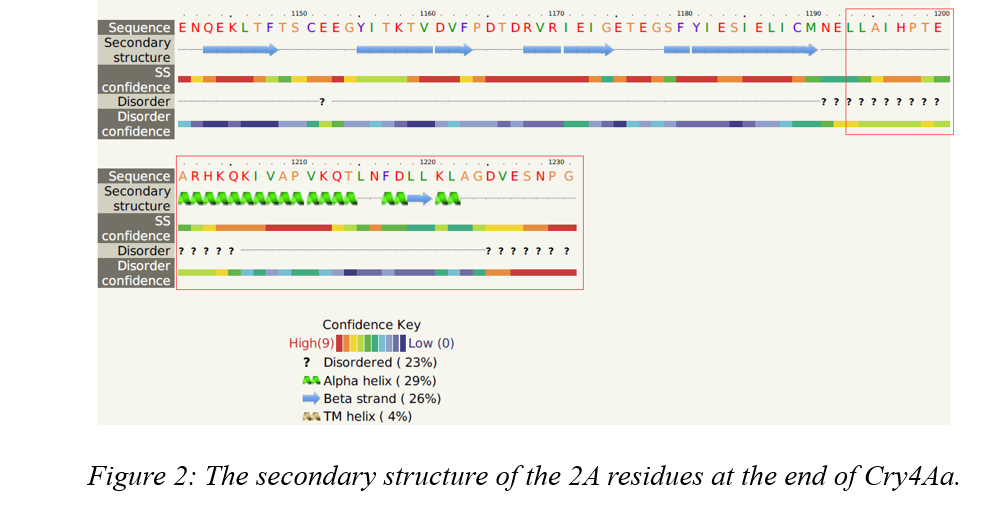Contents
Model
Protein Structure- Supported by SCU-CHINA
In 2016 iGEM competition, FAFU-CHINA aims to use the combination of Cry and Cyt toxins to control mosquito larvae in order to decrease the disease transition like Malaria and Zika from mosquito. 2A peptides is an effective tool to co-express two different proteins with one single vector. However, when 2A peptides is cleaved during the translation, residues with a length of about 20 amino acids are remained at the end of the upstream protein and a proline remained at the beginning of the downstream protein. Because of this, we are not sure about whether the residues would affect the structure and function of the proteins that we are going to express in Chlamydomonas reinhardtii, especially the Cry toxins. Therefore, SCU-CHINA team helped Tong Tong used Phyre2 to predict the secondary and tertiary structure of Cry4Aa, Cry10Aa and Cry11Aa with 2A residues. Unfortunately, the structure of Cry10Aa and Cry11Aa have not been elucidated by using X-ray crystallographic methods. Hence there is no good template in PDB database can be used and a large number of errors are reported from the results of homologous model construction for Cry10Aa-2A and Cry11Aa-2A. We were unable to estimate the effects of 2A residues to these two Cry toxins. However, the structure of Cry4Aa has been reported since 2006. We submitted the amino acid sequence of Cry4Aa-2A to Phyre2 website, using the normal mode and obtained a series of result of the homologous model. We got a reliable homologous model of Cry4Aa-2A (Fig. 1).</p>
<p style="text-indent:24pt"> We also obtained secondary structure analysis from the result of Phyre2. Since the 2A residues structure which has a length of 39 aa is our interest, so we carefully looked into that and found about half of residues are disordered and another half are mainly α-helix and a short β-strand (Fig. 2). Thus, we have reason to believe that the 2A residues does little impact to our Cry4Aa toxin, and it's feasible to use 2A peptides as a link between Cry and Cyt toxin for co-expression in a single vector.</p>
<p style="text-indent:24pt"></p>
<p align="center" style="text-align:center"> </p>
<p></p>
<p style="text-indent:24pt"> </p>
<p style="text-indent:24pt">The 2A peptides we designed for the co-expression contains 40 amino acids. After the cleavage during translation, all the amino acids except the last proline (39 aa in the red frame) are linked at the end of Cry4Aa toxin. The secondary structure analysis shows that the residues have little effect on the structure and function of the toxin.</p>
<p align="right" style="text-indent:24.0000pt;text-align:right"> </p>
<p align="right" style="text-indent:24.0000pt;text-align:right"> </p>
<p align="right" style="text-indent:24.0000pt;text-align:right">Written by Zenkun Lv (SCU-CHINA) and Tong Tong (FAFU-CHINA)</p>
<p align="right" style="text-indent:24.0000pt;text-align:right"> </p>
<p style="text-indent:24pt"> </p>
<p style="text-indent:24pt"> </p>
<p style="text-indent:20.9pt">It's essential for us to get accurate growth condition of Chlamydomonas reinhardtii in the natural environment to keep the concentration of toxin at a lethal level. But in fact, it is almost impossible to test concentration anywhere due to the lack of equipment and skills. Therefore, building the growth model can help determine the amount of Chlamydomonas reinhardtii they should use and when they need to add more. To build an accurate growth model, BNU-China team members who have much experience in the mathematics helped us to achieve it.</p>
<p style="text-indent:20.9pt">Contacting with data provided by wet laboratory, we can draw the diagram of variation trend of algae population. Then we can get the key point where rate of algae population increment meets the maximal value so that the results can guide to culture of algae in their wet part. To control quantity of aquatic larva of mosquito by applying expression of specific protein in algae. There is an impressive impact of establishing mathematic modeling in population of algae.</p>
<p style="text-indent:20.9000pt">They helped us to establish a mathematic model to illustrate the whole temporal change of algae population. In general, it's an original differential equations based on light intensity, mineral nutrient, organism and carbon dioxide, which are four main parameters in that. As for the temporal changing rate of population of algae growing in ideal conditions, there has been a lot of methods to solve this question. They referred to Huisman model and combined with practice factors. Then we got our deducted model. This model has a few parameters and it's easy to get the solution.</p>
<p style="text-indent:20.9000pt">We provided the data of wet laboratory for us, and they run the model to get result. Finally, these results can help us to complete experiment. </p>
<p style="text-indent:21.0000pt">The fundamental way that the algae grow is through photosynthesis, in which the inorganic carbon in the water (carbon dioxide) can be transformed into the organic carbon (carbohydrate). However, the photosynthesis of the algae, which is fixed in the water, is influenced and limited by lots of factor.</p>
<p style="text-indent:21.0000pt">Not only in the laboratory but also the factory, Culturing algae in the stirred-well mixed culturing vessel with fixed volume is a common way. Under the circumstances, we believe that those important parameters, which is related to the growth of the algae, are all isotropy. In another word, by only considering the result which is dependent on time, we can meet the requirements of the experiments, or even the production.</p>
<p style="text-indent:21.0000pt">Thus, after weighing up the actual conditions, based on the combination of the existing model of the first order ordinary differential equations, we set up some second order ordinary differential equations to simulate the growth velocity - the algae's dry weight of the time derivative. Furthermore, the results, which the model has simulated the growth condition of the algae in limited light and nutritive substance, quite tally with the actual situation. In some limiting cases, such as limited light with unlimited nutritive substance or unlimited light with limited nutritive substance, these equations can be simplified into some common first order ordinary differential equations.</p>
<p align="center" style="text-indent:24.0000pt;text-align:center">Figure1: The logical relationships among four parameters</p>
<p style="text-indent:21.0000pt">Firstly, according to the flow figure below, we explain the logical relationship of the four important parameters of the model. </p>
<p style="text-indent:21.0000pt">The growing speed of the alga in the incubator, A, which means the change of dry weight of the alga in unit interval is equal to the increase minus the decrease of the organic substance in the cells. The decrease is mainly based on two ways. One is the natural death and the other is the artificial separation of the useful mature alga.</p>
<p style="text-indent:21.0000pt">The carbon dioxide in the water area is converted to saccharides by the photosynthesis of alga and then stored in the cells. This also shows the conclusion that the growth of the population density of the alga will accelerate the speed of the decrease of carbon dioxide. Hence the content of carbon is equal to the inflow minus the part which are converted by photosynthesis.</p>
<p style="text-indent:21.0000pt">Similarly, the content of mineral substance in the water area M is also a factor which has its influence on photosynthesis. It will decrease faster when the amount of the alga is increasing as well.</p>
<p style="text-indent:21.0000pt">In a certain space, the sum of the carbohydrate, S (exclusive that in the cell), can be considered as the result which the fixed sum of the photosynthesis subtracts the total sum of the increment of the dry weight and the decrement of the dry weight in the culturing medium. (death, artificial extraction).</p>
<p align="center" style="text-align:center">Figure2: The quantitative relationships among four parameters</p>
<p align="center" style="text-indent:24.0000pt;text-align:center">Figure3: The reaction of photosynthesis</p>
<p>We know that the coefficient of the carbon dioxide which is consumed by carbohydrates is 44/33g [CO2] g[CH2O]-1. If the increment of the carbohydrates' dry weight is influenced only by the content of the organic matters and mineral substance, and the proportion of the two is 1:9 approximately, the coefficient of the consumed mineral substance, k2, is: </p>
<p style="text-indent:24pt"> </p>
<p align="center" style="text-align:center">Figure4: The equation of k2</p>
<p>The coefficient of the consumed organic matters, k3, is:</p>
<p> </p>
<p align="center" style="text-align:center">Figure5: The equation of k3</p>
<p style="text-indent:21.0000pt">From the above, what can be seen is that the main idea of these ordinary differential equations is element conservation. They work out the growth velocity indirectly by analyzing the transform of the substances in the fixed space.</p>
<p align="center" style="text-indent:24.0000pt;text-align:center">Figure 6. The model result of Algae concentration </p>
Reference
<p style="margin-left:20.9000pt;text-indent:-20.9000pt">[1] Jayaraman S K, Rhinehart R R. Modeling and Optimization of Algae Growth[J]. Industrial & Engineering Chemistry Research, 2010, 54(33).</p>
<p align="center" style="text-align:center">Acknowledgement</p>
<p align="center" style="text-align:center">Zhiyao Chen and BNU-CHINA team.</p>
<p> </p>
<p align="right" style="text-align:right">Written by Zhiyao Chen (BNU-CHINA team member) and Junhao Lu</p>
<p style="text-indent:24pt"> </p>
<tbody>
Growth Model of Chlamydomonas reinhardtii – Supported by BNU-CHINA
1.Introduction
2.Hypothesis of Model
3.Mathematic Formulation
<p align="center" style="text-indent:24.0000pt;text-align:center"> </p>
4.Result










